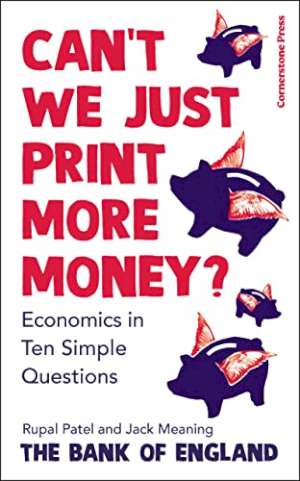25 July 2022
Can’t We Just Print More Money?
Economics in Ten Simple Questions
Rupal Patel and Jack Meaning
2022, Cornerstone Press, 275 pages,
ISBN 9781847943385
Reviewer: Rosemary Connell

This book is part of an effort better to explain the work of the Bank of England and to spread the word about economics and the workings of the economy. It provides a basic education in economics for all ages.
The authors delve into the reasons why demands change over time – prices, fashion, utility, income, conspicuous consumption etc. Demand is a result of choices made by many having balanced a myriad of trade-offs. Supply is to some extent the mirror image of demand.
The authors cover topics including profit maximisation, market failures, the pros and cons of monopolies, and the pricing of positive and negative externalities.
Each chapter discusses one of the 10 questions and the appendix refers to 51 simpler questions. There is only one equation in the whole book. Models are deemed never to be wholly correct but nevertheless can be useful.
The authors explain the way GDP (Gross Domestic Product) is measured, pointing out its shortcomings, and despite these, its usefulness. The key drivers of economic growth are the four factors of production, land, labour, capital and technology. Economic growth may lead to a better quality of life and increased happiness, but it can also lead to a higher level of inequality and a negative impact on the environment including climate change. The path to sustainable growth is far from easy.
How trade benefits economic growth through specialisation and comparative advantage is described with some examples. Evolution over time leads to ever-changing world trade patterns.
The causes and effect of inflation are explained. It can be seen as a tax on keeping money as it reduces debts, shifting some spending power from the old to the young. Deflation has the opposite effect leading to a lack of demand as people hold onto cash, hoping to buy more cheaply in the future.
The authors remind us of the panorama of items used as “money” from teeth, stones, cigarettes, metal and paper. We are reminded of Adam Smith’s definition of money, but at its core, money is trust. Given its huge fluctuations, Bitcoins do not meet Adam Smith’s criteria.
Economic and financial crises are analysed: their frequent occurrence, and reasons why they are so difficult to forecast. Examples of Bubbles and Minsky Moments are featured.
How QE (Quantitative Easing) works in practice is explained. Starting in Japan when lowering interest rates further seemed to have reached the end of the road, QE was used. It then was taken up by a number of countries including the UK.
Another important and fairly recent development in the financial world was the establishment of a central bank independent of the Government with a central mandate to meet an inflation target. This began in New Zealand and has since been implemented elsewhere including the UK.
This book is an excellent introduction to Economics, rivalling some first year student’s diet of Samuelson. It covers the basic building blocks of economics with a wealth of everyday examples which are easy to relate to, and shows how economics works. Along the way interesting historical facts are enumerated and historical data about some banking systems and workings are outlined.
It is a well written book that is easy and interesting to read.
Give it or lend it to anyone who is sceptical about economics or economists, or to anyone who is keen to learn the basics of economics and how it affects all our lives.
